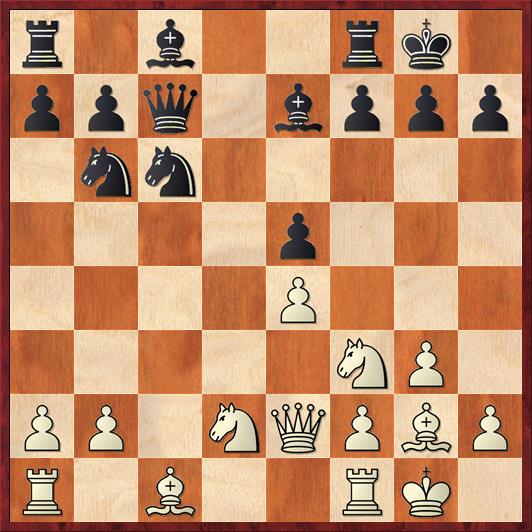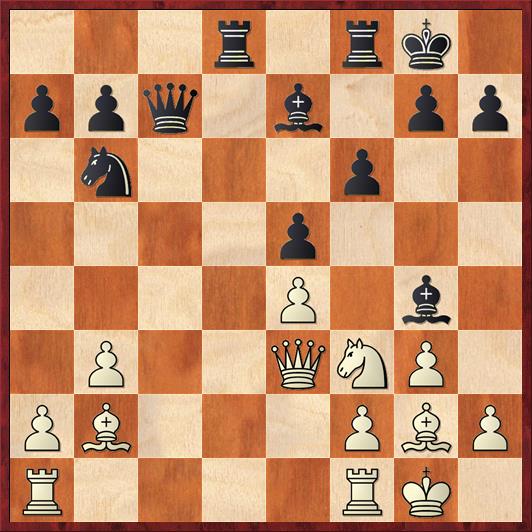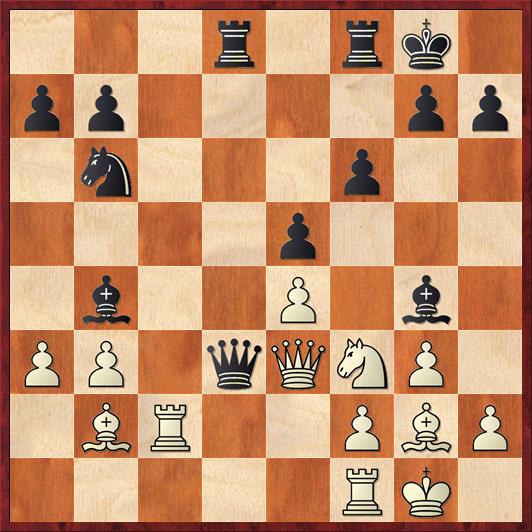Last night I played my fourth round in the Tuesday Night Marathon at the Mechanics Institute Chess Club in San Francisco. I won a nice game against a very friendly class-A player named Jonathan Mendoza. That brought my score to 3-1, with two wins, a draw and a half-point bye.
To me the most interesting point about the game was that it provided another example (not the first one in this blog) of the Mike Splane Question: How am I going to win this game?
I’d like to show you two positions, one a little bit before the crucial point and then the one where I popped The Question.
Position after 12. … e5. White to move.
FEN: r1b2rk1/ppq1bppp/1nn5/4p3/4P3/5NP1/PP1NQPBP/R1B2RK1 w – – 0 13
I’m playing White here. The position is a good representative of a general class of positions that you don’t see too often in chess books: positions where you have screwed up a little bit, and it’s not too terrible yet, but you want to make sure that things don’t get worse. I spent 12 minutes on this position (hmm… that already makes it worse) and considered several candidate moves, each one of which had certain problems.
(a) 13. Nb3 was my first instinct, but I didn’t like the fact that 13. … Be6 develops a piece with a threat (… Bc4). In general I felt as if I should commit my knight to a square after I see where his queen bishop goes to.
(b) Same thing for 13. Nc4. After 13. … Nxc4 14. Qxc4 Be6 he develops with a threat and I feel as if he’s going to start taking over all the open lines.
(c) 13. a3 keeps his knight out of b4, which is nice, but it wastes a tempo on a non-developing move and invites … Bg4 and … Nd4.
(d) 13. h3 keeps the bishop out of g4, but again it’s a non-developing move and he can just play 13. … Be6, after which my knight on d2 is paralyzed.
The more I looked at it, the more I felt that the fundamental flaw with my position was that I can’t complete my queenside development. I’d like to move my d2 knight but really can’t afford to, as explained above. Moves like a3 and h3 only postpone dealing with the problem. The only thing to do is to confront the problem head-on and play 13. b3. This move, too, creates a weakness — a hole on c3 — but that’s not so easy for Black to exploit. Plus, White will be better equipped to deal with … Bg4 and … Nd4 (as we’ll see). And b3 has other benefits. It creates tesuji against the knight on b6, which has no constructive moves, and it draws the poison out of the move … Be6, so that I can be pretty certain that … Bg4 is coming. And last but certainly not least, it allows me to develop my problem piece.
So the key question here was: What is my worst piece and how do I make it better?
The game continued, as I expected, 13. … Bg4 14. Bb2 Nd4. This looks at first blush like a dangerous move but it’s really not. I think that was the other key discovery during my “long think.” After 15. Qd3 I’m immediately threatening to win a pawn. Moves like 15. … Nc2? 16. Rc1 or 15. … Qc2? 16. Qxc2 Nxc2 17. Rc1 are bad for Black. So Black doesn’t have any followup other than the move he played, 15. … Nxf3+, but this is completely harmless for White. It trades off Black’s most dangerous piece and allows me to, in effect, get rid of my own d2 knight that was getting in the way of my other pieces. After 16. Nxf3 Rad8 17. Qe3 f6 we get to our second interesting position.
Position after 17. … f6. White to move.
FEN: 3r1rk1/ppq1b1pp/1n3p2/4p3/4P1b1/1P2QNP1/PB3PBP/R4RK1 w – – 0 18
Notice that Black’s move was his first purely defensive move of the game, which threatens absolutely nothing. This marks a key turning point, because it means that White is able to take over the initiative, and if you know anything about my chess you know that I value the initiative. This was the point where I thought that I could first realistically ask the Mike Splane Question: “How will I win this game?”
The one thing that jumped out at me was that 17. … f6 was a Band-Aid but not a solution. The weakness at the core of Black’s position is the dark-squared pawn chain, and I felt certain that somehow the victory would involve that pawn chain in some key way. Maybe a frontal assault with f4. Maybe an opportune piece sac on e5. Or maybe Black’s dark-squared bishop would be imprisoned behind the pawn chain and run out of good squares. And guess what? Because I was focused on that pawn chain, I eventually spotted a resource that my opponent missed.
Of course, the first move here was obvious: 18. Rac1, gaining a tempo and starting my strategy of taking squares away from Black’s bishop. Mendoza played the equally obvious 18. … Qd7, and I continued 19. Rc2, and then he surprised me with the clever move 19. … Bb4.
With this move he reminds me that I’m not exactly home free. If I play the careless 20. R1c1, he might play the stunning queen sacrifice 20. … Qd1+!? I’m not quite sure whether this wins, but I certainly don’t want to face it. So I played 20. a3, putting the question to the bishop. I was a little bit reluctant to play this because it weakens the b3 pawn, but then I saw something… Not anything forced, but something that he might overlook.
In fact, Mendoza was thinking along exactly the same track, and he thought that he had a perfect opportunity to take back the initiative with 20. … Qd3? This would be an excellent move but it has one Achilles’ heel.
Position after 20. … Qd3. White to move.
FEN: 3r1rk1/pp4pp/1n3p2/4p3/1b2P1b1/PP1qQNP1/1BR2PBP/5RK1 w – – 0 21
Here’s where the Mike Splane Question came to my rescue. After 21. Qxd3 Rxd3 I immediately saw the winning move, 22. Nxe5! (Actually, I saw this back on move 20.) It’s possible that my opponent saw it too, but just didn’t analyze far enough. Because of the fork, Black is forced to take, 22. … fe 23. ab. And now it’s possible that Black should just defend the pawn with 23. … Nd7, but he would remain a pawn down. Understandably, he didn’t like that idea because he thought he could win the pawn back with 23. … Rxb3. I played 24. Bxe5, and now it dawned on him that he could not play his intended 24. … Rxb4? because of 25. Bd6, forking the two rooks. Instead he changed his mind and played 24. … Rd8, but after 25. Rc7 Rd7 26. Rxd7 Nxd7 27. Bd6 I consolidated my extra pawn.
It’s funny how a little trick like that can be the difference between a win and a draw, or at least between an easy win and a very long, hard battle. He actually soldiered on for 30 more moves, but the outcome was never really in doubt. White has an extra pawn, two active bishops, and a very mobile 4-2 pawn majority on the kingside.
Finally, changing the subject completely, I’d like to announce an event that might be of interest to any readers in the Berkeley area: the return of the Berkeley Chess School’s most famous alumnus! U.S. Champion Sam Shankland, now the 27th-rated player in the world, will come to the Berkeley Chess School next week for an intensive five-day, 15-hour workshop for players rated 1800 and above. The fee is $325. For more information and to enter, go to the Berkeley Chess School website.






{ 1 comment… read it below or add one }
Thanks for these real-world posts. Such games from normal players can often be more instructive than the high-level GM positions, because this is the type of positions we have to deal with in our chess lives.
After 15 Qd3 my first inclination as Black would be to play 15 … Rfd8 (or possibly 15 … Rad8). Now White has to decide whether the d-pawn is poisoned or not after something like 16 Nxd4 exd4 17 Bxd4 Bf6, or 16 Bxd4 with similar ideas. It will all come down to the pin, and whether or not Black can exploit it.